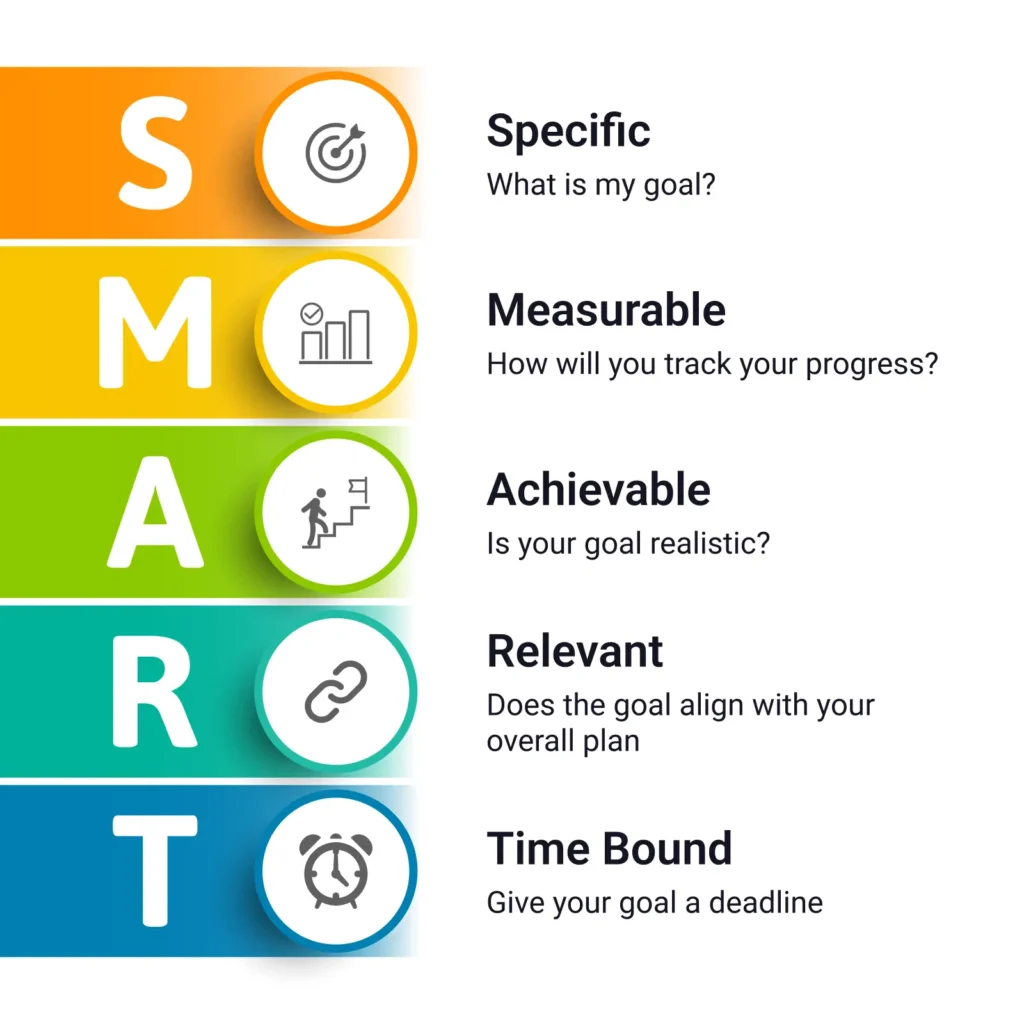INTRODUCTION
In career coaching, one of the most common questions professionals ask is: “How do I set goals I can actually achieve?” The answer lies in understanding what a SMART objective and Goal Setting stand for. SMART is not just a buzzword—it’s a powerful framework for turning vague ambitions into clear, actionable, and measurable results.
This blog will explain the SMART framework for goal setting, break down the SMART criteria for objectives, and show you how to apply them in your career or personal growth journey. Whether you are a student, a young professional, or a manager guiding a team, mastering SMART goals will give you clarity and confidence in achieving success.
What Does SMART Objective Stand For ?
At its core, SMART is an acronym that defines the essential features of a well-structured goal. A SMART objective stand for:
- S – Specific: The goal should be clear, detailed, and focused.
- M – Measurable: It must include criteria to track progress.
- A – Achievable: The goal should be realistic within available resources.
- R – Relevant: It must align with larger career or personal objectives
- T – Time-bound: Every goal should have a deadline to create urgency.
This specific measurable achievable realistic time bound and Goal setting approach transforms goals from wishful thinking into a step-by-step action plan.
Why Goal Should Be SMART ?

Many professionals struggle because their goals are too vague. For example, saying “I want to be successful” doesn’t give you direction. But if you apply the SMART criteria for goals, you might reframe it as:
“I want to earn a project management certification within six months to qualify for a leadership role.”
This type of objective smart goals is both clear and actionable.
Remember: a goal must be SMART to truly drive progress.
SMART Targets explained with examples.
Let’s break down some SMART targets explained with practical scenarios:
- For Students: Instead of “I want to study more”, set SMART targets for students such as “I will dedicate two hours each evening for exam preparation for the next 30 days.”
- For Professionals: Instead of “I want to improve my skills”, define a SMART goal description like “I will complete an advanced Excel course online by the end of this quarter.”
- For Managers: Instead of “I want my team to perform better”, set SMART goals and objectives such as “Increase team productivity by 15% over the next quarter by implementing weekly strategy meetings.”
These examples show why goals should be SMART—they create clarity and accountability.
The SMART Framework For Goal Setting in Career Coaching.
As a career coach, guiding clients to use the SMART goal framework is essential. The SMART Objective method of goal setting allows individuals to:
- Define SMART goals that are practical.
- Create an action plan SMART goals that breaks larger ambitions into manageable steps.
- Use the SMART principles for goal setting to stay motivated and consistent.
- Regularly evaluate progress through SMART goals explained reviews.
This process ensures that clients move steadily towards career growth while avoiding frustration from unrealistic objectives.
Define SMART Objectives vs. SMART Goals.
Many people wonder about the difference between define SMART objectives and define SMART goals. In practice:
- SMART Objectives are broader, long-term outcomes you want to achieve.
- SMART Goals are specific milestones that help you reach those objectives.
For example, your SMART criteria for SMART objectives may be “Become a marketing director in five years.” Your goal setting SMART goals along the way might include:
- “Gain two years of leadership experience within the next three years.”
- “Enroll in a digital marketing certification course within the next six months.”
This layered approach ensures clarity and progress.
SMART Goals for Students and Professionals.
The SMART goals for students provide structure for academic success, while professionals benefit from the SMART Objective approach to goal setting in their careers.
- Students learn time management, accountability, and focus.
- Professionals build measurable career milestones and align them with company objectives.
In both cases, using the SMART method goals helps track progress and stay motivated.
Action Plans and Time-Bound Goals.
A goal without a timeline is just a dream. That’s why it’s essential to set time bound goals.
For example:
- “Increase LinkedIn engagement by 20% within 90 days by posting weekly articles.”
- “Complete three new client proposals by the end of this month.”
An action plan SMART goals includes deadlines, resources, and specific steps to achieve success. This makes your ambitions practical instead of overwhelming.
The Power of the SMART Criteria Stands for
When you apply the SMART criteria stands for method, you move from general aspirations to structured plans. It’s not just about writing down what you want—it’s about creating a roadmap that leads to measurable success.
The beauty of the SMART goal approach is that it can be applied to any area of life: career development, education, health, or personal growth
The SMART Method of Goal Setting in Real Life.
The SMART method of goal setting has applications in every career. For example:
- A professional aiming for promotion can use the SMART goal setting method to gain skills, seek mentorship, and show measurable contributions to their company.
- Entrepreneurs use SMART framework for goal setting to structure business growth strategies, from revenue goals to client acquisition targets.
- Job seekers benefit by applying the SMART criteria to set goals, such as “Apply to five companies weekly and secure at least three interviews in the next two months.”
Goal Must Be SMART Objective: Final Thoughts
If there’s one principle to remember, it’s this: a goal must be SMART. Ambitions without structure often lead to frustration, but SMART goals bring clarity, structure, and motivation.
The SMART criteria for goals ensure that each step is measurable, relevant, and time-bound, so clients stay focused and confident.
Conclusion
Understanding what a SMART objective stand for is not just about decoding an acronym—it’s about transforming careers. By applying the SMART principles for goal setting, professionals and students alike can achieve clarity and consistent progress.
As a career coach, your role is to guide clients in using the SMART goal approach, developing action plan SMART goals, and reviewing progress regularly.
Ultimately, goals should be SMART—because success is never accidental; it’s the result of clarity, planning, and consistent action.
